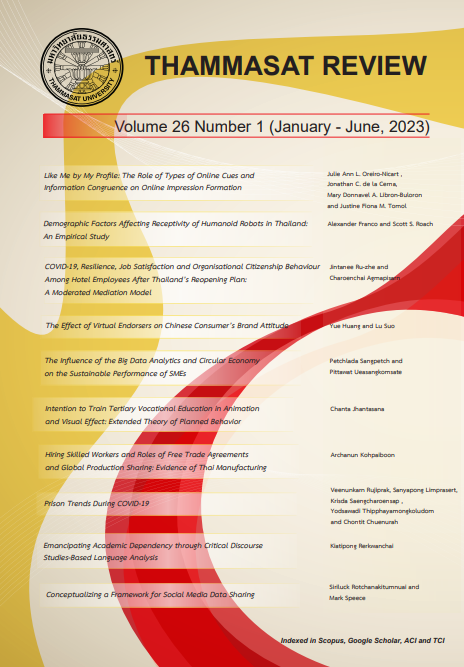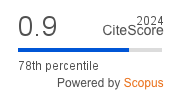Like Me by My Profile: The Role of Types of Online Cues and Information Congruence on Online Impression Formation
Keywords:
Online impression formation, Online cues, Information congruenceAbstract
Abstract
With adolescents at the forefront of Information and Communication Technology (ICT) adoption, the researchers investigated the online cues that influence online impression formation. This is based on the premise that social cues contribute to the formation of people's impressions of others, and that these impressions in turn influence behavior. On the assumption that computer-mediated communication (CMC) is socially impoverished, it was hypothesized that, given limited exposure, trustworthiness impressions would be predominantly based on visual cues (i.e., photos) rather than verbal cues (i.e., statements). In addition, it was hypothesized that the type of online cues (visual, verbal, or mixed) and information congruence (congruent, incongruent) would influence trustworthiness impressions of an online target, which would in turn influence behavioral intentions to engage in future interactions. Participating in the investigation were one hundred forty-five (145) junior high school students. Except for the function of the type of online cues (visual, verbal, or mixed) on trustworthiness impressions, where no main effect was found, all study hypotheses were supported. Overall, the results are consistent with the lens model (Brunswik, 1956) which proposes that online cues correspond to a target's trait, and that observers use these online cues to form impressions of the target, as well as the warranting theory (Walther & Parks, 2002; Hall, Pennington, & Lueders, 2013) which proposes that observers assign warranting values to online cues, thereby creating a link between the online and offline self. Given the benefits and risks of ICT, the findings of this study have significant implications for understanding the psychological mechanisms that facilitate online behavior, particularly among young users.
References
Adaval, R., Isbell, L. M., & Wyer, R. S., Jr. (2007). The impact of pictures on narrative- and list- based impression formation: A process interference model. Journal of Experimental Social Psychology, 43(3), 352-364. https://doi.org/10.1016/j-jesp.2006.04.005
Amurthalingam, S. (2022, November 14). Social Media Statistics in the Philippines. Meltwater. https://www.meltwater.com/en/blog/social-media-statistics-philippines
Arnett, J. (2000). Emerging Adulthood: A theory of development from the late teens through the twenties. American Psychologist, 55(5), 469-480.
Asch, S. (1946). Forming impressions of personality. Journal of Abnormal and Social Psychology, 41(3), 258-290.
Bordia, P. (1997). Face-to-face versus computer-mediated communication: A synthesis of the experimental literature. Journal of Business Communication, 34, 99–120.
Brambilla, M., Rusconi, P. P., Sacchi, S., & Cherubini, P. (2011). Looking for honesty: The primary role of morality (vs. sociability and competence) in information gathering. European Journal of Social Psychology, 41, 135–143.
Brooks, J. & Freeman, J. (2019). Neuroimaging of person perception: A social- visual interface. Neuroscience Letters. 693, 40-43. DOI: 10.1016/j.neurlet.2017.12.046
Brunswik, E. (1956). Perception and the representative design of psychological experiments. Berkeley: University of California Press.
Cooper, J., Blackman, S., & Keller, K. (2015). The Science of Attitudes (1st ed.). New York: Routledge.
Culnan, M. J., & Markus, M. L. (1987). Information technologies. In F. M. Jablin, L. L. Putnam, De Bruin, E. N. M., & Van Lange, P. A. M. (1999). Impression formation and cooperative behavior. European Journal of Social Psychology, 29(2-3), 305– 328.
DeAndrea, D. C. (2014). Advancing warranting theory. Communication Theory, 24, 186-204. DOI: 10.1111/comt.12033.
Duck, S. W. (1982). Interpersonal communication in developing acquaintance. In G. R. Miller (Ed.), Explorations in interpersonal communication (pp. 127–148). Beverly Hills: Sage.
Ekman P, Friesen WV. (1969). Nonverbal leakage and clues to deception. Psychiatry, 32(1), 88-106. DOI: 10.1080/00332747.1969.11023575.
El Asam, A. & Katz, A. (2018). Vulnerable young people and their experiences of online risks. Human-Computer Interaction, 1-24. DOI: 10.1080/07370024.2018.1437544.
Gawronski, B. (2012). Back to the future of Dissonance Theory: Cognitive consistency as a core motive. Social Cognition, 30(6), 652-668.
Gifford, R. (2006). Personality and nonverbal behavior: A complex conundrum. In Manusov, V., & Patterson, M. L. (Eds.), The SAGE Handbook of Nonverbal Communication (pp. 159-199). Thousand Oaks, CA: Sage
Hall, J. A., & Pennington, N. (2013). Self-monitoring, honesty, and cue use on Facebook: The relationship with user extraversion and conscientiousness. Computers in Human Behavior, 29, 1556-1564. DOI: 10.1016/j.chb.2013.01.001.
Hall, J. A., Pennington, N., & Lueders, A. (2013). Impression management and formation on Facebook: A lens model approach. New Media & Society, 16, 958-982. DOI: https://doi.org/10.1177/1461444813495166.
Hamilton, D., & Carlston, D. (2013). Emergence in Social Cognition. In Bodenhausen, G. & Hamilton, D., Katz, L., & Leirer, V. (1980a). Cognitive representation of personality impressions: Organizational processes in first impression formation. Journal of Personality and Social Psychology, 39(6), 1050-1063.
Hamilton, D., Katz, L., & Leirer, V. (1980b). Organizational processes in impression formation. In Hastie, R., Ostrom, T., Ebbesen, E., Wyer Jr., R., Hamilton, D., & Carlston, D. (Eds.), Person Memory, 121-153. Hillsdale, NJ: Erlbaum.
Hiltz, S. R., & Turoff, M. (1978). The Network Nation. Cambridge, MA: MIT Press.
Howe, M.A. (1989). Using imagery to facilitate organizational development and change. Group and Organizational Studies, 14 (1). 70-82. DOI: 10.1177/105960118901400107
International Telecommunication Union (2022). Measuring digital development: Facts and Figures. International Telecommunication Union (ITU). https://www.itu.int/en/ITU-D/Statistics/Pages/facts/default.aspx
Jensen, M. L., Meservy, T. O., Burgoon, J. K., & Nunamaker Jr, J. F. (2010). Automatic, multimodal evaluation of human interaction. Group Decision and Negotiation, 19, 367-389. DOI: 10.1007/s10726-009-9171-0.
K. H. Roberts, & L. W. Porter (Eds.), Handbook of organizational communication: An Interdisciplinary perspective (pp. 420-443). Newbury Park, CA: SAGE.
Lambert, A. (Eds.) Foundations of Social Cognition. Lawrence Erlbaum Associates, Inc. Mahwah, NJ. ISBN: 0415654904, 978-0415654906
Livingstone, S. & Helsper, E. J. (2007) Taking risks when communicating on the Internet: the role of offline social-psychological factors in young people's vulnerability to online risks, Information, Communication & Society, 10(5), 619-644, DOI: 10.1080/136911 80701657998
Marcus, B., Machilek, F., and Schultz, A. (2006). Personality in cyberspace: personal websites as media for personality expressions and impressions. Journal of Personality and Social Psychology. 90(6), 1014-1031. DOI:10.1037/0033-3514.90.6.1014
Milyavskaya, M., Reoch, J., Koestner, R.F. & Losier, G.F. (2010) Seeking social connectedness: interdependent self-construal and impression formation using photographic cues of social connectedness. Journal of Social Psychology, 150(6), 689-702. DOI: 10.1080/00224540903365406
Pagliaro, S., Brambilla, M., Sacchi, S., D’Angelo, M., & Ellemers, N. (2013). Initial Impressions Determine Behaviours: Morality Predicts the Willingness to Help Newcomers. Journal of Business Ethics, 117, 37–44. https://doi.org/10.1007/ s10551-012-1508-y
Pelled, A., Zillberstein, T., Tsirulnikov, A., Pick, E., Patkin, Y., & Tal-Or, N. (2017). Textual primacy online: impression formation based on textual and visual cues in Facebook profiles. American Behavioral Scientist, 1-16. DOI: 10.1177/0002764217717563
Postmes, T., Spears, R., & Lea, M. (1998). Breaching or building social boundaries? SIDE-effect of computer-mediated communication. Communication Research, 25, 689–715.
Quine, W. & Ullian, J. (1978). The web of belief (2nd ed.). New York: McGraw-Hill.
Riva, G. & Galimberti, C. (1998). Computer-mediated communication: Identity and social interaction in an electronic environment. Genetic, Social and General Psychology Monographs, 124, 434-464.
Simpson, J. (2002). Computer-mediated communication. ELT Journal, 56(4), 414-415.
Statista Research Department (2022, November 17). Social media in the Philippines- statistics and facts. Statista. https://www.statista.com/topics/6759/social-media-usage-in-the-philippines/#topicOverview
Stone, A. R. (1995) The War of Desire and Technology at the Close of the Mechanical Age. Cambridge, MA: MIT Press.
Tanis, M. & Postmes, T. (2003). Social cues and impression formation in CMC. International Communication Association, 676-693. DOI: 10.1111/j.1460-2466.2003.tb02917.x.
Thoresen, J. C., Vuong, Q. C., & Atkinson, A. P. (2012). First impressions: gait cues drive reliable trait judgements. Cognition, 124(3), 261–271. https://doi.org/10.1016/ j.cognition.2012.05.018
Tong, S. T., Van Der Heide, B., Langwell, L., & Walther, J. B. (2008). Too much of a good thing? The relationship between number of friends and interpersonal impressions on Facebook. Journal of Computer-Mediated Communication, 13, 531-549. DOI: 10.1111/j.1083-6101.2008.00409.x.
Tsankova, E. (2013). First impressions of trustworthiness: the roles of the impression target, the impression holder, and the physical environment (Unpublished dissertation). Jacobs University, Bremen, Germany.
Tsankova, E., & Kappas, A. (2015). Facial Skin Smoothness as an Indicator of Perceived Trustworthiness and Related Traits. Perception, 45(4), 400-408. https://doi.org/ 10.1177/0301006615616748
Tsankova, E., Krumhuber, E., Aubrey, A., Kappas, A., Möllering, G., Marshall, D., & Rosin, P. (2015). The multi-modal nature of trustworthiness perception. In: Proceedings of the 1st Joint Conference on Facial Analysis, Animation, and Auditory-Visual Speech Processing (FAAVSP), 147-152. ISCA: Vienna, Austria.
Tyler, T. R., & Blader, S. L. (2003). The group-engagement model: Procedural justice, social identity, and cooperative behavior. Personality and Social Psychology Review, 7, 349–361.
Walther, J. B., & Parks, M. R. (2002). Cues filtered out, cues filtered in: Computer-mediated communication and relationships. In M. L.
Knapp & J. A. Daly (Eds.), Handbook of Interpersonal Communication (3rd ed., pp. 529-563). Thousand Oaks, CA: Sage.
Walther, J. B., Van Der Heide, B., Hamel, L. M., & Shulman, H. C. (2009). Self-generated versus other-generated statements and impressions in computer-mediated communication: A test of warranting theory using Facebook. Communication Research, 36, 229-253. DOI: 10.1177/0093650208330251
Walther, J. B., Van Der Heide, B., Kim, S.-Y., Westerman, D., & Tong, S. T. (2008). The role of friends’ appearance and behavior on evaluations of individuals on Facebook: Are we known by the company we keep? Human Communication Research, 34, 28-49. DOI: 10.1111/j.1468-2958.2007.00312.x
Walther, J. B. (1996). Computer-mediated communication: impersonal, interpersonal, and hyperpersonal interaction. Communication Research, 23(1), 3-43. DOI: 10.1177/009365096023001001
Wang, S. S., Moon, S. I., Kwon, K. H., Evans, C. A., & Stefanone, M. A. (2010). Face-off: Implications of visual cues on initiating friendship in Facebook. Computers in Human Behavior,26, 226-234.
Whittle, H., Hamilton-Giachritsis, C., Beech, A., & Collings, G. (2013). A review of young people’s vulnerabilities to online grooming. Aggression and Violent Behavior, 18, 135-146. DOI: http://dx.doi.org/10.1016/j.avb.2012.11.008.
Willis, J. & Todorov, A. (2006) First impressions: making up your mind after a 100-ms exposure to a face. Psychological Science, 17(7), 592-598.
Winkielman, P., & Nowak, A. (2022). Beyond the Features: The Role of Consistency in Impressions of Trust. Social Psychological Bulletin, 17, 1-20. https://doi.org/10.32872/ spb.9233
Wojciszke, B. (2005). Morality and competence in person- and self-perception. European Review of Social Psychology, 16(1), 155-188. DOI: 10.1080/10463280500229619
Downloads
Published
How to Cite
Issue
Section
License
Copyright (c) 2023 Thammasat Review

This work is licensed under a Creative Commons Attribution-NonCommercial-NoDerivatives 4.0 International License.
The opinions and ideas expressed in all submissions published in Thammasat Review are solely that of the author(s) and do not necessarily reflect that of the editors or the editorial board.
The copyright of all articles including all written content and illustrations belong to Thammasat Review. Any individuals or organisation wishing to publish, reproduce and distribute a particular manuscript must seek permission from the journal first.








